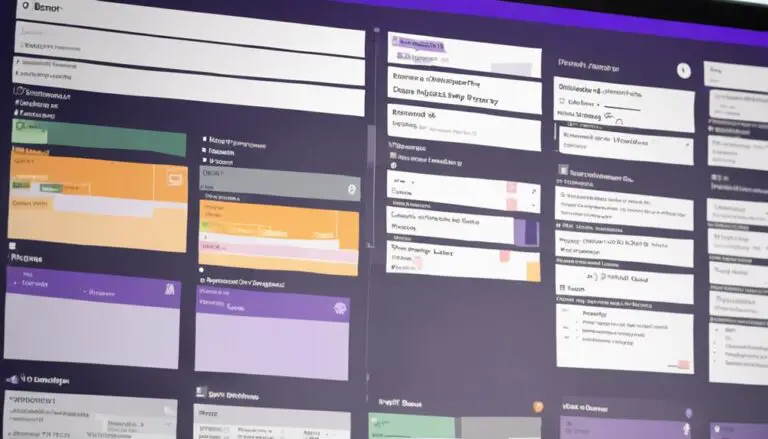In the realm of Kanban, estimates play a crucial role in guiding task management and project success. By delving into how Kanban utilizes estimates, you will uncover a structured approach that not only aids in forecasting project completion but also assists in efficient resource allocation and task prioritization.
This method of estimation not only enhances collaboration within teams but also ensures accurate project planning and execution. The mystery lies in how these estimates seamlessly integrate into the Kanban framework, optimizing workflow and fostering continuous improvement.
Key Takeaways
- Estimates guide project completion predictions and align team goals in Kanban.
- Estimated completion times influence task prioritization and resource allocation strategies.
- Accurate estimates balance workloads, prevent delays, and optimize task management.
- Estimation metrics enhance workflow efficiency, task sequencing, and timely completion in Kanban.
Importance of Estimates in Kanban
Estimates in Kanban serve as a cornerstone for effective project management, guiding stakeholders towards accurate predictions of project completion times. Within Kanban, estimates are crucial for setting expectations and aligning team goals.
By incorporating estimates into Kanban boards, teams can visualize the scope and complexity of tasks, enabling better resource allocation and capacity planning.
Common estimation techniques like T-Shirt Sizing, Planning Poker, and Wideband Delphi are utilized to provide a range of estimates that reflect the uncertainty inherent in projects.
Role of Estimates in Task Prioritization
Estimates play a crucial role in task prioritization by impacting scheduling, facilitating resource allocation based on the estimated effort, and enhancing project planning.
Impact on Scheduling
In task prioritization within Kanban, the utilization of estimated completion times significantly influences scheduling and resource allocation decisions. By considering cycle time estimates and Work In Progress (WIP) limits, teams can effectively sequence tasks for optimal workflow.
Task estimates serve as a compass, guiding you on which tasks to tackle first to ensure timely delivery and efficient resource utilization. These estimates empower you to prioritize effectively, aligning your efforts with project objectives and deadlines.
Resource Allocation Based
Task prioritization within Kanban hinges on effectively allocating resources based on the estimated time and effort required for each task. Estimates guide teams in determining which tasks should be addressed first, considering the estimated completion times and resource allocation needs.
By utilizing estimates for task prioritization, Kanban ensures that high-priority tasks are given precedence, optimizing workflow efficiency. These estimates play a vital role in facilitating decision-making regarding resource allocation, allowing teams to manage their workload effectively.
Through the strategic allocation of resources based on estimated completion times, Kanban teams can streamline their processes and enhance overall productivity. This methodical approach to resource allocation based on estimates enables teams to meet deadlines and deliver tasks in a timely manner.
Enhances Project Planning
Enhancing project planning through the role of estimates in task prioritization involves a detailed analysis of the effort required for each task. By providing accurate estimates, Kanban enables project managers and teams to make informed decisions on task sequencing based on estimated completion times. This process aids in effective resource allocation and scheduling, optimizing workflow and ensuring project deadlines are met.
Kanban's focus on high-priority tasks and efficient dependency management is facilitated through the use of task estimates. By utilizing estimates in task management, Kanban enhances project planning, leading to successful project outcomes as tasks are completed within the expected timeframes.
Efficient Resource Allocation Through Estimates
Efficiently allocating resources through accurate estimates is essential for optimizing task management in Kanban. By predicting task completion times, Kanban enables teams to balance workloads effectively. This balance ensures that tasks are distributed among team members in a manner that maximizes resource utilization.
Accurate estimates play a crucial role in identifying bottlenecks within the workflow, allowing for timely adjustments to maintain stability. Through the reliance on estimates, Kanban enhances productivity by aligning task assignments with available resources, thereby preventing overburdening or underutilization of team members.
The ability to forecast task completion times not only aids in resource allocation but also contributes to improved decision-making regarding task prioritization and team capacity. Ultimately, the efficient allocation of resources through accurate estimates is vital for achieving optimal task management within the Kanban framework.
Setting Realistic Project Timelines With Estimates
Optimizing project timelines in Kanban relies heavily on the strategic utilization of estimates, particularly by considering key metrics like lead time and historical data. By analyzing lead time, which is the duration from task initiation to completion, teams can gauge how long similar tasks have taken in the past. This historical data forms the basis for setting realistic project timelines, ensuring tasks are completed within expected time frames.
When setting project timelines with estimates, it's crucial to leverage historical data to make informed decisions. By referencing how long comparable tasks have historically taken, teams can create more accurate estimations for current tasks. This approach enhances project planning by providing a solid foundation for forecasting when tasks will be completed. Consequently, realistic project timelines based on estimates contribute to preventing delays and enhancing overall project efficiency in Kanban.
In Kanban, the strategic use of lead time and historical data enables teams to establish project timelines that align with past performance, fostering predictability and sustainable workflow management. By incorporating these key metrics into the estimation process, Kanban ensures tasks are completed efficiently and within the anticipated time frames.
Enhancing Workflow With Estimation Metrics
Estimation metrics play a crucial role in enhancing your workflow efficiency. By utilizing metrics like lead time and cycle time, you can prioritize tasks effectively and understand the impact of estimates on your project timelines.
These metrics provide valuable insights for optimizing your workflow, ensuring smoother task management and resource allocation.
Estimation for Task Prioritization
Utilizing estimation metrics such as cycle time and throughput in Kanban enhances task prioritization by providing insights into task complexity and resource requirements.
By leveraging Kanban estimation, teams can effectively prioritize tasks based on their impact on workflow, identifying critical tasks requiring immediate attention while optimizing task sequencing.
Accurate estimates facilitate efficient resource allocation, ensuring a smooth flow of work and timely task completion.
Through estimation for task prioritization, Kanban focuses on high-value tasks and minimizes bottlenecks, thereby enhancing overall workflow management.
Impact of Estimates
Enhancing workflow with estimation metrics in Kanban involves leveraging insights gained from estimates to effectively manage task completion times and project timelines. By accurately estimating performance, Kanban teams can make informed decisions and streamline their processes.
The impact of estimates in Kanban includes:
- Improving project planning by forecasting timelines based on estimation metrics.
- Enhancing resource allocation and capacity planning through precise estimates.
- Managing work in progress efficiently to maintain flow and productivity.
These factors showcase how estimates play a crucial role in optimizing workflow and driving continuous improvement within Kanban practices. By embracing estimation metrics, teams can achieve greater efficiency and effectiveness in their task management strategies.
Lead Time in Kanban Estimation
Lead time in Kanban estimation is a crucial metric that measures the duration from task request to completion. It provides valuable insights for workflow optimization. By understanding lead time, teams can predict task delivery durations, identify bottlenecks, and enhance workflow efficiency. This metric aids in resource allocation and task prioritization. Tracking lead time allows teams to optimize their processes by streamlining workflows and ensuring tasks are completed within expected timeframes.
Variability in lead time can highlight areas that require attention, leading to more accurate task management and planning in Kanban. Through analyzing lead time data, teams can make informed decisions regarding task assignments and resource utilization, ultimately improving overall productivity and project outcomes. Utilizing lead time effectively in Kanban estimation enables teams to achieve better task management practices, fostering a more efficient and organized work environment.
Understanding Cycle Time in Kanban
Cycle time in Kanban, a fundamental metric, provides valuable insights into the efficiency of task completion within a workflow. Understanding cycle time is crucial for effective task management.
Here are three key points to consider:
- Measuring Completion Time: Cycle time in Kanban measures the duration taken to complete a task from initiation to conclusion. This metric helps teams gauge the efficiency of their workflow and identify areas for improvement.
- Identifying Bottlenecks: By tracking cycle time, teams can pinpoint bottlenecks or delays in their processes. This insight enables teams to streamline their workflow, optimize resource allocation, and enhance overall productivity.
- Forecasting and Decision Making: Monitoring cycle time allows for better forecasting of project timelines and delivery estimates. Analyzing cycle time data empowers teams to make informed decisions, prioritize tasks effectively, and continuously refine their workflow for maximum efficiency.
Throughput and Estimates in Kanban
Understanding how throughput and estimates function in Kanban is essential for optimizing task completion and project planning efficiency. Throughput in Kanban refers to the rate at which tasks are completed within a specific time frame.
By estimating throughput, teams gain insights into their capacity for task completion and project delivery. This data is crucial for resource allocation, workload balancing, and overall project planning. Analyzing throughput metrics helps teams identify bottlenecks, streamline workflows, and enhance efficiency.
Throughput-based estimates enable teams to make informed decisions, prioritize tasks effectively, and meet project deadlines. By incorporating throughput into their workflow, teams can better manage their Kanban Backlog, ensuring a steady flow of work and improved project outcomes.
Utilizing throughput and estimates in Kanban empowers teams to enhance productivity, optimize processes, and achieve successful project outcomes.
Work in Progress Limits in Estimation for Kanban
Implementing Work in Progress (WIP) limits is a fundamental strategy in the Kanban system for effectively managing task estimation and workflow efficiency. WIP limits help control the number of tasks in progress simultaneously, preventing overloading the team and ensuring a focus on completing tasks effectively. These limits are customized to the team's capacity, balancing workload and maintaining a steady flow in the workflow. In Kanban boards, WIP limits are visually represented by restricting the number of tasks allowed in specific stages, aiding in optimizing efficiency and reducing delays.
- WIP limits control the number of tasks in progress.
- Setting WIP limits prevents overloading and ensures task completion focus.
- Kanban boards visually represent WIP limits to maintain workflow efficiency.
Frequently Asked Questions
How to Use Kanban for Task Management?
To use Kanban for task management, begin by visualizing tasks on boards. Track metrics like lead and cycle times for accurate time tracking. Limit work in progress, focus on completing efficiently, and adapt estimates for better resource allocation.
How Do You Estimate a Story in Kanban?
To estimate a story in Kanban, break it into tasks, assign relative sizes like story points, and collaborate with your team for consensus. Consider complexity, effort, and dependencies, regularly updating estimates based on feedback.
How Does Kanban Measure Productivity?
To measure productivity in Kanban, track lead time, cycle time, throughput, and adhere to WIP limits. These metrics provide insights into task completion efficiency and overall performance tracking, ensuring work is managed effectively for optimal results.
How Does Kanban Board Help to Track Progress of a Sprint?
Track your sprint progress effortlessly with Kanban boards. Progress visualization aids team collaboration and workflow efficiency. Move tasks across columns for a clear sprint overview. Stay focused, identify bottlenecks, and ensure timely task completion.
Conclusion
In conclusion, Kanban utilizes estimates for task management to drive efficiency, collaboration, and informed decision-making within teams. Kanban also promotes continuous improvement through visualizing work and limiting work-in-progress, which ultimately leads to higher productivity and quality. Additionally, kanban board completion allows teams to see the progress of their tasks in real-time, enabling them to make data-driven adjustments to their workflows. This transparency and focus on completing tasks helps teams stay organized and on track to meet their goals.
For example, a software development team used Kanban estimates to accurately forecast project completion dates, allocate resources effectively, and prioritize tasks based on lead time and cycle time metrics.
By leveraging estimation techniques, teams can optimize their workflow, improve project planning, and achieve successful outcomes in a structured and data-driven manner.





